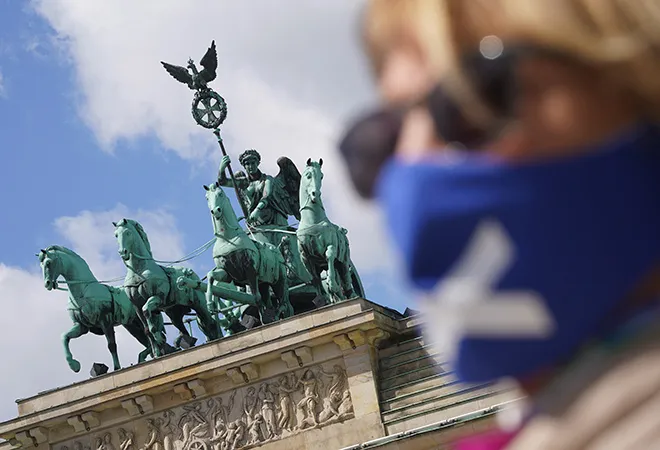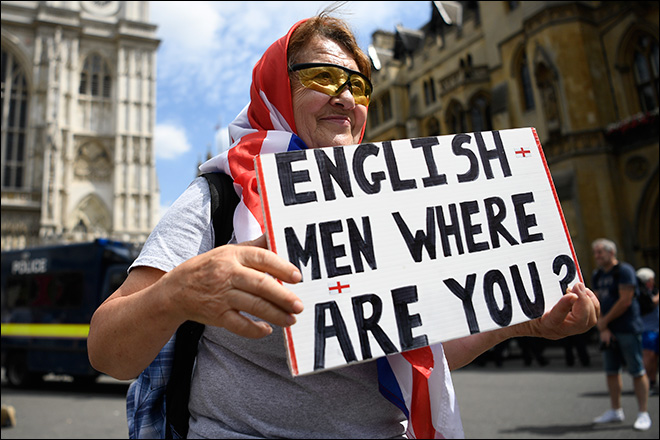
Europe has long suffered from far-right politics and extreme right terrorism. Over the past decade, however, the terrorism associated with the ideology has grown in influence and potency. The increasing mainstreaming of racist narratives which hold non-whites culpable for the current dire state of affairs has brought fringe views into broader public view. At the same time, Europe has seen a growth in an increasingly networked and armed extreme rightwing, showing a threat picture evolving in worrying directions.
Mainstreaming far-right narratives
In Europe, just as in some other parts of the world, governments’ bid to contain the spread of COVID-19 brought rightwing extremists to the forefront of anti-lockdown protests. In Germany, for instance, extremists have attended rallies organised by a mainstream far-right political party, Alternative for Germany (AfD), and leveraged the pandemic to spread anti-semitic and racist conspiracy theories. Many of these theories have attributed Jews as the source of the crisis and reason for lockdown, and blamed migrants for being the original carriers of the virus.
Mostly focused on immigration, they tap into racist sentiment dressing it up as nationalism to move closer to power.
Separately, the killing of a Black American man, George Floyd, on 25 May 2020 by a police officer in Minnesota, has ignited anti-racist protests and counter-protests globally. Rightwing extremists in Europe are exploiting the chaos to conduct counter-protests against “white racism” in Paris, the tearing down of national monuments linked to slavery and colonialism in London, and ultimately to incite violence.
This trend of the extreme right taking advantage of the chaos generated during COVID-19 and the race protests is not surprising. But it comes after a general trend in European politics of the mainstreaming of far-right voices. Be it France’s Front Nationale, Germany’s AFD, UKIP in the UK, Italy’s Lega Nord, Spain’s Vox or Victor Orban in Hungary, there has been a growing trend across Europe in the past decade or more of parties mainstreaming far-right narratives. Mostly focused on immigration, they tap into racist sentiment dressing it up as nationalism to move closer to power. In some cases, they have achieved their goal and won political office, but in others they have served to simply drag the existing mainstream right deeper towards their narratives as they attempt to reclaim the political territory.
The growing mainstreaming of nativism is also not exclusive to the rightwing, and is visible at the other end of the political spectrum as well.
The net result of this shift is previously fringe narratives and parties being brought closer to the center. In turn, this means the extreme right is also brought in, empowering those on the hard edges who see the winds blowing in their direction and an opportunity to capitalise. In Germany, this link has been quite explicit, with the radical wing of AfD (known as Der Flügel) placed under surveillance by German domestic intelligence. The growing mainstreaming of nativism is also not exclusive to the rightwing, and is visible at the other end of the political spectrum as well. Some leftist parties are fighting to “bring back” populist votes by championing “ours first” policies in their electoral campaigns. This is visible in the Danish Social Democrats or Italy’s leftist Five Star movement which has been willing to enter into coalition with far-right parties to get into power.
A European Union of hate
Somewhat paradoxically given their tendency to oppose the European Union, these far-right political groups have found themselves networking across the continent. Drawing on each other’s successes, they have held rallies together, spoken admiringly of each other as a way of highlighting the substance to their movement across the Continent, and even formed political blocs in the Union. This connectivity is something that is equally visible on the extreme right, where groups like the English Defence League (EDL) have been emulated across Europe. And on the even harder edge, we can see how terrorist groups or individuals are linking up across the continent. Anders Behring Breivik, a man who presented himself as the forefront of a movement with his attack in Norway in 2011 and has subsequently become something of an icon to parts of the extreme right, reported contacts with extremists in the Balkans, as well as attended EDL marches in the UK.
Multiplying concerns has been the growth in links to battlefields and training camps.
In the UK, the case of Pavlo Lapshyn, a Ukrainian student who moved to Birmingham in 2013 and launched a one-man terror campaign against the West Midlands Muslim community, was an early indicator of what could come. Britain First, the fringe far-right group, has found support in Eastern Europe with its leadership going to rallies in Poland, posting materials in Polish and hosting Poles in London. Some of their Polish followers have launched attacks in the UK. This link draws on the 1990s when UK far right extremists made connections with their counterparts in Eastern Europe. Networks of extremists from Germany, Eastern Europe and Nordic countries have long formed sub-cultures around the white power music scene. This has provided a backdrop for networks of extreme right-wing terrorists like the Nationalist Socialist Underground (NSU) in Germany.
Further multiplying concerns has been the growth in links to battlefields and training camps. Rightwing extremists in Europe have travelled and developed relations with individuals and networks within and outside of the continent, and vice versa. White supremacist groups originating from the United States, such as The Base, also have presence in Europe. The ongoing crisis in Ukraine has turned it into a battlefield pitting pro-Russian separatist against ultra-nationalist groups, and turning it into a transnational hub attracting foreign fighters to join both sides. The Azov Battalion is known to have conducted recruitment outside of Ukraine and trained white supremacists who have travelled to Ukraine. Fighters from across Europe have shown up, with a number tracing links to far-right groups back home.
 © Leon Neal/Getty
© Leon Neal/Getty
The growing cooperation is not only restricted to Ukraine. The Russian Imperial Movement (RIM), a Russian ultra-nationalist, quasi-paramilitary organisation, has hosted training camps that have attracted Swedish, Finnish and German extremists. Some went to Ukraine, but others returned home. German neo-Nazis, particularly the youth wings of two neo-Nazi German political parties, the National Democratic Party and The Third Path, attended camps before returning home to promulgate far-right ideas. Two Swedish members of the Nordic Resistance Movement who trained with RIM went on to construct explosive devices which they used to target sites in Sweden associated with migrants in 2016 and 2017. The US has recently designated RIM as a Specially Designated Global Terrorist (SDGT) entity, partly for its role in these attacks.
Ideological twist and shout
There is also a growing confusion at the ideological end of the spectrum. The nexus between far-right political ideologies and extreme rightwing, non-affiliated lone terrorists, is murky and has in some cases led to acts of extremism and terrorism perpetrated by lone terrorists being politicised. Germany’s AfD was initially blamed for Tobias Rathjen’s 19 February shootings at a series of shisha bars in Hanau, though there was no evidence of a link and ultimately questions were raised around Rathjen’s mental state. Similarly, the murder of UK MP Jo Cox by Thomas Mair was initially associated with the group Britain First, given his past involvement with the group and reports of him shouting the group’s name during his attack. The link was ultimately revealed to be unclear and denied by the group.
The nexus between far-right political ideologies and extreme rightwing, non-affiliated lone terrorists, is murky and has in some cases led to acts of extremism and terrorism perpetrated by lone terrorists being politicised.
This ideological confusion between violence and politics has become even more opaque with the growth of ideologically overlapping subcultures online. While the classic extreme right of neo-Nazi’s, skinheads and hooligans still exist, they are now joined by fringe ideologies such as “incel” (which is shorthand for “involuntary celibate,” an adherent who believes that attractive women and men are to be blamed for their inability to find a romantic or sexual partner), anti-government movements such as Sovereign Citizens (which already has sizable membership in Europe), QAnon or conspiracy theorists focused on the dangers of 5G technology. These ideas, ideologies, online sub-cultures all merge together and have produced terrorist attacks. A growing number of European cases draw on a range of these ideologies, with a strong extreme right undertone tying them together. Philip Manshaus (August 2019 Bærum mosque attack), Stephan Balliet (attempted October 2019 Halle synagogue attack), and Tobias Rathjen (February 2020 shisha bars attack), were all triggered by their hatred for immigrants, but showed incel refrains in their manifestos. Even if the fringe ideology may not have been the main driver to the act of terror, the convergence of rightwing extremist ideologies (e.g., white supremacism), inceldom and conspiracy theory driven movements is increasing.
At the other end of the ideological construction there is a problem of reciprocal radicalisation where elements of the extreme right draw their motivation from ideological adversaries on the far-left or violent Islamists. But there has also been a growth of groups subsuming ideological strands or messaging from opposing groups into their own ideologies — in part out of acknowledgement of success others have had in projecting their messages. For example, the UK’s National Action talked of white jihad, used tactics and imagery aping ISIS, while stirring up neo-Nazi messaging and using the direct-action political activism reminiscent of al-Muhajiroun.
There has also been a growth of groups subsuming ideological strands or messaging from opposing groups into their own ideologies — in part out of acknowledgement of success others have had in projecting their messages.
Overall, however, an underlying narrative that tends to drive the extreme right in Europe is the “Great Replacement” theory, which promulgates that “indigenous European population is replaced by non-European migrants.” Anders Brevik and Tobias Rathjen have cited the incipient threat of white genocide in their manifestos as reasons for taking up arms to fight against the colonisation of western civilisation. This is a narrative also popular amongst some far-right and libertarian politicians across Europe.
What the future holds
Extreme rightwing terrorism in Europe has contributed an increased share of total terrorist attacks in the last five years (in some years, it even represented the largest threat). According to Europol’s figures, notwithstanding reporting issues (member states have a habit of reporting in different ways), there has been a consistent increase in reported arrests on the extreme right since 2015 (coinciding with the migrant crisis), and these numbers have more than doubled between 2017 and 2018, potentially demonstrating heightened counter-terrorism efforts. Just in June this year, the German Interior Ministry placed a ban on the anti-semitic rightwing extremist group, Nordadler. In the same month, the Belgian government reported that some 20 of its citizens have participated in paramilitary training camps in Eastern Europe in recent years. As reciprocal radicalisation, lone actor attacks drawing on a mixture of warped extreme right ideologies, and mainstreaming of far-right ideas continue to grow, the problem is not going away. With violent Islamist threat appearing to retreat, rightwing extremism and terrorism remain amongst the most dangerous ideologies on the continent, and a growing force to be reckoned with.
The views expressed above belong to the author(s). ORF research and analyses now available on Telegram! Click here to access our curated content — blogs, longforms and interviews.




 © Leon Neal/Getty
© Leon Neal/Getty PREV
PREV


